Seeds of a range of delphinium species from Asia and North America from several sources for 'botanical seeds' were sown in pots of compost on 20th January or 31st January and left exposed to the weather outdoors. The first germination was noted in several species after 30 days, although in some pots there has been no germination so far or just one or two seedlings after rain in July.
The problems with most batches of seedlings began when the seedlings were large enough to prick out. For seedlings which had just developed a true leaf, the root was often 150mm or more in length and it was inevitable that many seedlings suffered root damage when being transferred to individual pots. Weather conditions were also often unhelpful. Seedlings of several species, for example D. amabile, failed to maintain progress after an encouraging start and eventually either lapsed into dormancy or died. In most cases, relatively few seedlings have thrived and grown large enough for planting out in the garden. The picture below shows seedlings at the end of May, when most seedlings looked to be thriving. The problem for some of these seedlings is now one of keeping the pots dry until next spring in the hope that dormant root tubers will then start into growth!
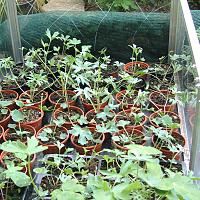 |
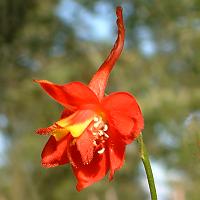 |
The real excitement of growing species is when the first flowers open and that stage has now been reached for several of the American species. Seedlings of D. cardinale, shown in the picture above, flaunted their brilliant scarlet flowers in the garden from early August onwards.
While D. cardinale was already familiar, several other species were being grown for the first time. The first flowers at the end of June were those of pot-grown seedlings of D. recurvatum and D. parryii purpureum. Plants of these species in the open ground grew more vigorously with extensive branching of the stems and are flowering in late July. The pictures below show the basal stem branching and flowers of a plant of D. recurvatum with a main flower spike 75cm tall that is surrounded by many upright secondary flower stems. The flowers are pinkish mauve rather than a clear pale blue. The growth habit looks ideal for a floriferous garden plant but perhaps the cultural requirements are too demanding for it to have become familiar in cultivation.
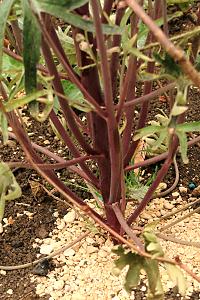 |
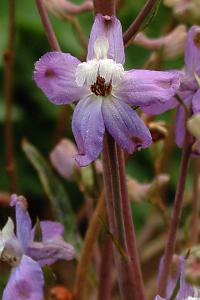 |
Four other species from the USA have flowered. The first two were pot grown seedlings of D. glaucum and D. virescens. Florets of these are seen in the pictures below. The flower of D. glaucum seen on the left is 25mm in diameter, which is rather small for a plant that is 85cm tall with a short spike of 10 widely spaced florets. The white flower of D. virescens is 30mm across on a rather feeble plant and the flowers were unfortunately damaged at night by pests.
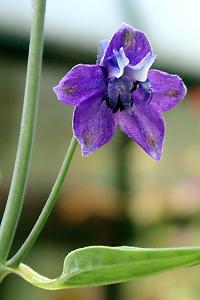 |
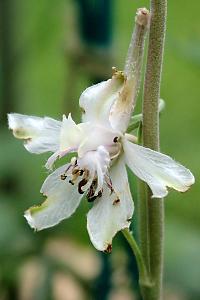 |
Flowering of D. variegatum, a dwarf delphinium from California, was triggered by rain from a thunderstorm which flooded the pots. The flower stem emerged from the basal rosette of leaves within two days and grew to about 30cm tall. With their slender long spur, the large purple-blue florets (left hand picture below) that opened in late August look very like the flowers of cultivated dwarf delphiniums such as 'Blue Butterfly' derived from D. grandiflorum, a species from Asia.
The heavy August rain also seemed to encourage flowering of D. californicum ssp interius. A sturdy stem emerged from the basal rosette of large leaves and grew to 120cm tall. The pale greenish white cupped florets are only 10mm diameter and have interesting pink tinged petals and spur. With 70 of these curious tiny flowers on very short stalks scattered like beads along the flower spike, this plant has to rank as one of the more bizarre species of delphinium.
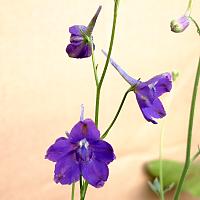 |
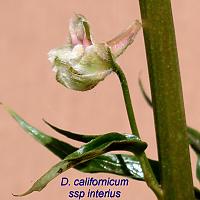 |
Another candidate for a collection of delphinium curiosities has to be D. maackianum, a species from Siberia and Manchuria grown from seed supplied by Chiltern Seeds. The seedlings were rather like those of D. vestitum in having very hairy, large fleshy leaves. The plants showed no sign of flowering until mid August, when a stem with more deeply divided leaves began to grow. The really odd feature of this species (left hand picture below) is the appearance of the inflorescence when it first appears, as the flower buds are completely sheathed by large reddish bracts on the stem. Sideshoots developing in leaf axils below the bloom also look like miniature Brussel sprouts! Once the bloom develops, the flowers emerge from their sheath and the bloom has a familiar form with dark violet-blue florets held well away from the stem. This delphinium seems extremely susceptible to powdery mildew.
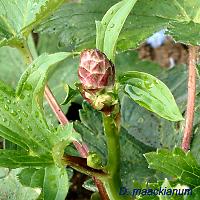 |
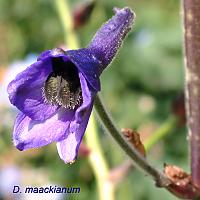 |
| Return to Contents List |
Delphinium orfordii (AGS03-23620) illustrates the difficulties of raising some delphinium species from seed. Sown in January 2003, the seed germinated in March but only one or two seedlings developed a true leaf before the seedlings became dormant. The seed pot was left exposed to the weather for the rest of the year. Signs of new growth were seen early in January 2004 and by the end of the month there were many seedlings with true leaves. This is characteristic behaviour for plants that develop a root tuber in their first year. The seedlings were pricked out into individual pots in early February.
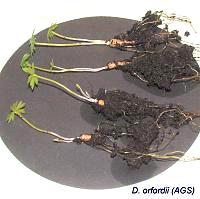 |
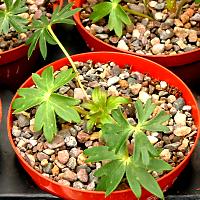 |
When the seedlings were separated from the compost in the pot, they were found to have tapered root tubers with fibrous roots up to 15cm long, as seen on the left above. The seedlings were then potted up in fresh compost. By late March, some plants, like that on the right above, looked likely to produce flowers and they were repotted into 1litre pots.
All plants grew vigorously, producing a few shiny, thick-textured leaves and branching stems terminating in a short spike of a few widely spaced flowers on long stalks. Flowering began in mid May and continued throughout June (left-hand picture below). Most plants remained compact with flower stems growing to 25cm or less in height but a few grew to 50cm. The flowers ranged in colour from clear mid blue, through deep purplish blue shades to pure mauves and one plant even had flowers of a very pale pinkish lavender that faded to pale grey (right hand picture below). The lateral sepals reflexed strongly back as the flowers aged.
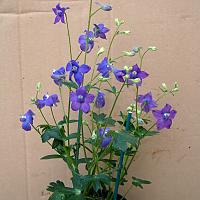 |
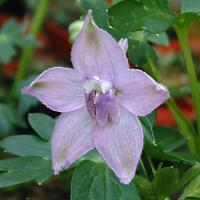 |
These seedlings were excellent early-flowering pot plants. It would be nice to know more about the origin of D. orfordii, which is not included in the the list of Delphinium Species in the Flora of North America. The only reference I know implies that it may be a form of D. nuttallianum. My seedlings of that species appear very diffferent and in their second year grew only two highly dissected leaves before becoming dormant once more.
The worst cultural problem encountered was botrytis (grey mould), which caused rotting at the base of the flower stem. Several plants were lost when seed was developing, either due to overwatering or inadequate ventilation in the cold frame in poor weather. This problem has also affected most other delphiniums with tuberous roots
D. caucasicum (AGS2350) and D. speciosum (AGS 2369)
Plants of both species survived in the open ground and grew vigorously. The stems were significantly more robust with many more flowers than last year. The tough, woody stem of D. caucasicum grew to 90cm tall, tapering gradually towards the tip from a 6mm thickness at the base. The large, widely spaced flowers started about 30cm from the ground. With the large leafy bracts at the base of each floret stalk, the resemblance of this plant to a campanula, such as the nettle leaved bellflower, was really pronounced. Plants of D. speciosum also grew much larger than in their first year and the bell-shaped flowers were very pretty.
The differences between the two species grown were quite small but their character is very different from normal garden delphiniums.
The flowers were large with bell-shaped flaring of the sepals rather like that of a campanula. This is seen for florets of D. caucasicum in the right hand picture below.
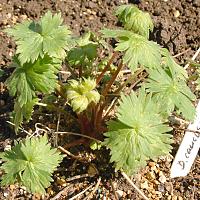 |
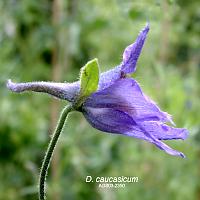 |
D. menziesii(AGS03-2359)
The seedlings quickly developed true leaves and flowered in July 2003. This is a sure indication that the seed is not that of D. menziesii. Seed of the true species from North America germinates and develops in the same way as described above for D. orfordii and seedlings would not be expected to reach flowering size in the first year.
The plants grown have attractive bright blue flowers similar to cultivated forms of D. grandiflorum var chinense / D. tatsiense (left hand picture below). Whether the plants are really those of a distinct species is hard to determine. The plants survived winter well and flowered profusely in June/July 2004, when they could be compared with the flowers of a plant of D. menziesii pyramidalis grown by Shirley Bassett (right hand picture below). The flowers of the latter differ in many respects, one being that they form a tapering spike, another is the presence of small leaflets on the stem very close to the flower. As already noted, the really critical differences are in the intial development of the plants from seed and their root systems.
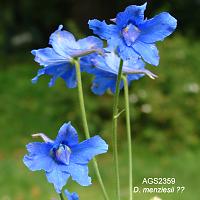 |
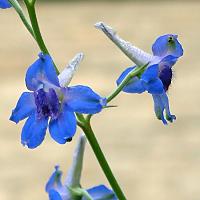 |
D. cashmerianum (AGS03-2349) & D. brunonianum (AGS2000)
These two species from the Himalayan region are notable for the unusual, broad form of the spur and the tendency of the flowers to hang downwards giving them an appearance similar to aconitums. The arrangement of flowers on the stem also differs from the familiar spike of florets characteristic of garden delphiniums. Unfortunately, many plants available under these species names are not the true species or are hybrids. Nevertheless it was interesting to have flowers in June on several plants of both species raised from seed from the Alpine Garden Society.
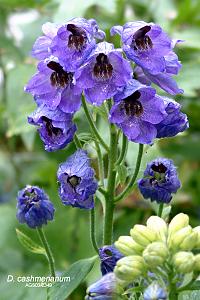 |
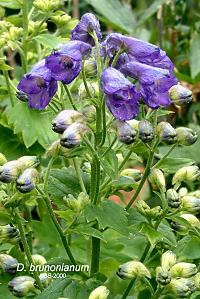 |
Plants of both batches were very similar in habit, producing several branched stems growing to 60cm in height. The flowers were arranged in a spike (raceme) but each flower stalk generally carried a small corymbose cluster of several flowers where there would normally be just a single floret. The top of the stem carries a much larger corymbose cluster of flowers which open first.
There were distinct differences between the two 'species'. The leaves of D.cashmerianum have much more serrated edges. The form of their flowers differs, as can be seen in the pictures below. The flowers of D.cashmerianum on the left have a more clearly defined spur than those of D. brunonianum on the right, which have a very broad based triangular cone. This difference could also be seen when the florets were viewed from above.
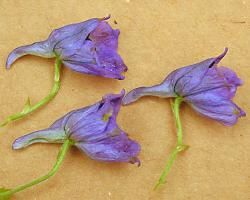 |
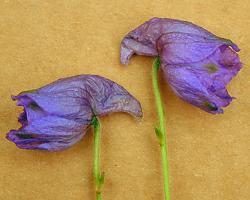 |
After pollination, the sepals of the flowers do not drop and the seed pods develop and ripen encased in decaying sepal remnants. In wet weather, this resulted in the development of grey mould and much of the potential seed crop was lost due to rotting of the seed heads. However, examining the seeds showed that D. brunonianum had seeds with very pronounced scales, very similar to those seen on seeds of D. semibarbatum. The seeds of D. cashmerianum are much smaller and appear to have a rough surface but not scales when examined at low magnification.
| Return to Contents List |
Flowers of Species raised in 2002
North American Species
D. tricorne
Four seedlings were raised in 2002 when they developed cotyledons only. One plant flowered in 2003 but then died due to rotting of the base of the stem. The other plants survived the winter and started to grow leaves from the top of the root tuber in mid March. Two plants flowered in May 2004.
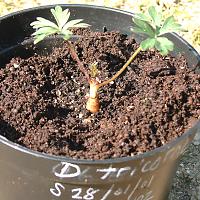 |
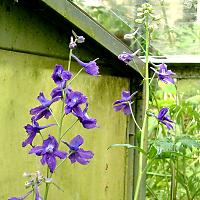 |
Asiatic Species
D. semibarbatum
Plants raised from seed sown in February 02 flowered in September and October 02. Two of the original plants survive to 2004, with their first flowers opening in mid July. Self sown seedlings germinated in the soil around one of the plants during the winter and these were also in flower by late July. The plants were ruined by heavy August rain.
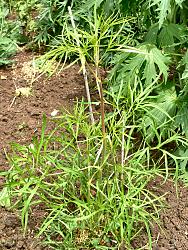 |
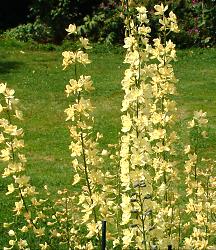 |